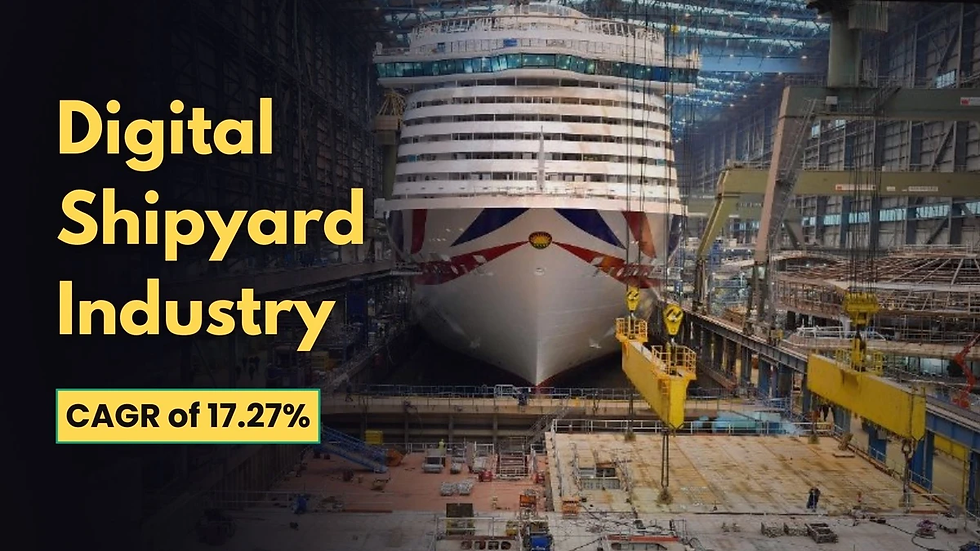Digital Shipyard Industry Size, Growth, Trends, Insights, Forecast, 2021–2028
- Rishika Chavan
- Aug 26
- 3 min read
According to Fortune Business Insights™, the global digital shipyard industry size stood at USD 963.6 million in 2020 and is projected to surge from USD 1,129.6 million in 2021 to USD 3,444.5 million by 2028, registering a CAGR of 17.27% during the forecast period. This growth is being accelerated by the maritime sector’s transition toward Industry 4.0 technologies, automation, and operational efficiency in both commercial and defense shipbuilding.
Market Overview
Digital shipyards represent a paradigm shift in the shipbuilding industry. By leveraging IoT, artificial intelligence (AI), digital twins, robotics, and additive manufacturing, shipbuilders are replacing traditional methods with highly automated and data-driven processes. These advanced technologies enable real-time decision-making, improved life-cycle management, and greater production agility.
The integration of cyber-physical systems (CPS) and robotic process automation (RPA) is streamlining operations, lowering costs, and accelerating vessel delivery timelines. With maritime trade continuing to expand and governments modernizing naval fleets, digital shipyards are quickly becoming a strategic necessity.

Key Market Insights
Adoption of digital twins, IoT-enabled sensors, and 3D modeling is improving efficiency across design, maintenance, and operations.
Leading shipbuilders are increasingly turning to predictive analytics and automated robotics to enhance productivity and safety.
Navantia (Spain) partnered with Siemens Digital Industries Software in 2019 to fully digitalize its shipbuilding operations.
Major Industry Players
Key companies driving digital shipyard innovation include:
IFS AB (Sweden)
Pemamek Oy (Finland)
Dassault Systemes (France)
BAE Systems (U.K.)
Altair Engineering, Inc. (U.S.)
AVEVA Group Plc. (U.K.)
Wartsila (Finland)
KUKA AG (Germany)
Damen Shipyards Group (Netherlands)
Prostep AG (Germany)
Information Source:
Market Segmentation
By Shipyard Type
Commercial Shipyards: Dominated the market in 2020, fueled by increasing global seaborne trade. With UNCTAD estimating 80% of global trade volume carried by sea, demand for digitalization in commercial shipyards is soaring.
Military Shipyards: Expected to grow steadily as governments invest in digital twins and next-generation defense technologies.
By Technology Platform
Robotic Process Automation (RPA): Held the largest market share in 2020, driven by automation in welding, cutting, and painting. For instance, a Ulsan-based shipyard reported saving USD 9.4 million annually through automated welding.
AI & Big Data Analytics: Accounted for 28.22% of the market in 2020 and projected to grow rapidly as AI-driven robotics reduce reliance on human intervention.
Additive Manufacturing, Digital Twin, Blockchain, IIoT: Emerging as transformative technologies for advanced shipbuilding.
By Digitalization Level
Semi-Digital Shipyards: Largest segment in 2020, as more companies adopt partial automation.
Fully Digital Shipyards: Forecast to record the highest CAGR, fueled by rising adoption of IIoT, AR, and digital twins in advanced shipbuilding projects.
Market Growth Drivers
Industrial Internet of Things (IIoT) IntegrationReal-time data, advanced sensors, and AI-driven analytics are boosting productivity, minimizing downtime, and improving workplace safety.
Rising Use of Robotics in ShipbuildingIndustry leaders like Hyundai Heavy Industries, Samsung Heavy Industries, and DSME are increasingly deploying robots across welding, assembly, and painting lines to reduce labor costs and improve quality.
Restraining Factor
High Capital Investment is considered a major restraint because adopting advanced systems requires significant upfront spending. Shipbuilders must invest heavily in specialized hardware such as sensors, navigation systems, and communication modules, along with software solutions for data processing, monitoring, and automation. On top of that, there are expenses for system integration, which ensures all components work seamlessly, and for ongoing maintenance, which adds to long-term costs.
For large shipbuilding companies, these expenses can be managed due to bigger budgets and government contracts. However, for small and mid-sized shipbuilders, the financial burden is much heavier. This cost barrier makes it difficult for them to implement advanced technologies at scale, ultimately slowing the overall adoption rate across the industry.
Emerging Market Trends
Additive Manufacturing Surge: The rapid adoption of 3D printing is transforming the shipbuilding sector by streamlining part fabrication and repair processes. On-site production of metal components significantly reduces lead times, minimizes downtime, and lowers overall costs. This technological shift enhances operational flexibility for shipbuilders and supports faster maintenance cycles, ultimately improving fleet availability and efficiency.
AI-Powered Smart Shipyards: The integration of advanced digital technologies is reshaping modern shipyard operations. For instance, in September 2024, ST Engineering launched a next-generation smart shipyard in Singapore that leverages artificial intelligence, 5G connectivity, Internet of Things (IoT), and predictive maintenance. This development highlights how smart maritime infrastructure is driving automation, improving operational efficiency, and setting new benchmarks for future shipbuilding and repair practices.
Regional Insights
Asia Pacific: Accounted for USD 323.3 million in 2020 and will remain the largest market, supported by dominant shipbuilders in South Korea, Japan, and China, which together build over 90% of global cargo ships.
Europe: Growth driven by investments in robotics, digital platforms, and 3D visualization tools.
North America: Expansion expected due to strong R&D activity and digitalization projects in naval shipyards.
Middle East, Africa, and South America: Moderate growth expected as governments explore fleet modernization and local shipbuilding investments.
Competitive Landscape
Market leaders are pursuing strategic collaborations, R&D investments, and automation projects to strengthen their position. Companies such as SAP and Accenture are collaborating to develop cloud-based shipbuilding solutions, while others are investing heavily in AI, IoT, and AR-based robotics.
Recent Developments
June 2021 – Drydocks World launched a digital transformation project with IFS Cloud for asset management and resource planning, laying the foundation for a fully digital shipyard.



Comments